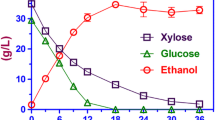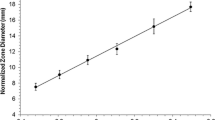Abstract
Low ethanol yields and poor yeast viability were investigated at a continuous ethanol production corn wet milling facility. Using starch slurries and recycle streams from a commercial ethanol facility, laboratory hydrolysates were prepared by reproducing starch liquefaction and saccharification steps in the laboratory. Fermentations with hydrolysates prepared in the laboratory were compared with plant hydrolysates for final ethanol concentrations and total yeast counts. Fermentation controls were prepared using hydrolysates (plant and laboratory) that were not inoculated with yeast. Hydrolysates prepared in the laboratory resulted in higher final ethanol concentrations (15.8 % v/v) than plant hydrolysate (13.4 % v/v). Uninoculated controls resulted in ethanol production from both laboratory (12.2 % v/v) and plant hydrolysates (13.7 % v/v), indicating the presence of a contaminating microorganism. Yeast colony counts on cycloheximide and virginiamycin plates confirmed the presence of a contaminant. DNA sequencing and fingerprinting studies also indicated a number of dissimilar communities in samples obtained from fermentors, coolers, saccharification tanks, and thin stillage.





Similar content being viewed by others
References
Abbott DA, Ingledew WM (2005) The importance of aeration strategy in fuel alcohol fermentations contaminated with Dekkera/Brettanomyces yeasts. Appl Microbiol Biotechnol 69:16–21
Basilio ACM, Araujo PRL, de Morais JOF, da Silva Filho EA, de Morais Jr MA, Simoes DA (2008) Detection and identification of wild yeast contaminants of the industrial fuel ethanol fermentation process. Curr Microbiol 56:322–326
Bischoff KM, Siqing L, Leathers TD, Worthington RE, Rich JO (2008) Modeling bacterial contamination of fuel ethanol fermentation. Biotech Bioeng 103:117–122
Chang IS, Kim BH, Shin PK, Lee WK (1995) Bacterial contamination and its effects on ethanol fermentation. Microbiol Biotechnol 12:309–314
Clarke K, Green R (1988) Statistical design and analysis for a ‘biological effects’ study. Mar Ecol Prog Ser 46:213–226
de Souza-Liberal AT, da Silva Fihlo EA, de Morais JOF, Simoes DA, de Morais Jr MA (2005) Contaminant yeast detection in industrial ethanol fermentation must by rDNA-PCR. Lett Appl Microbiol 40:19–23
de Souza-Liberal AT, Basilio ACM, do Monte Resende A, Brasileiro BTV, da Silva Fihlo EA, de Morais JOF, Simoes DA, de Morais MA Jr (2007) Identification of Dekkera bruxellensis as a major contaminant yeast in continuous fuel ethanol fermentation. Appl Microbiol 102:538–547
Drummond A, Ashton B, Cheung M, Heled J, Kearse M, Stones-Havas S, Thierer T, Wilson A (2009) Geneious v4.7. Available from http://www.geneious.com
Ingledew WM (2003) Continuous fermentation in the fuel alcohol industry: how does the technology affect yeast. In: Jacques KA, Lyons TP, Kelsall DR (eds) The alcohol textbook: a reference for the beverage, fuel and industrial alcohol industries. Nottingham University Press, Nottingham, pp 135–144
Johnson LA, May JB (2003) Wet milling: the basis for corn biorefineries. In: White PJ, Johnson LA (eds) Corn: chemistry and technology. American Association of Cereal Chemists, St. Paul, MN, pp 44–94
Kent AD, Jones SE, Yannarell AC, Lauster GH, Graham JH, Kratz TK, Triplett EW (2004) Annual patterns in bacterioplankton community variability in a humic lake. Microb Ecol 48:550–560
Legendre P, Legendre L (1998) Numerical ecology. Elsevier Science, BV, Amsterdam
Madson PW, Muttagh JE (1991) Fuel ethanol in USA: review of reason for 75% failure rate of plants built. IX International Symposium on Alcohol Fuels, Firenze, ISAF, pp 119–124
Muthaiyan A, Limayem A, Ricke SC (2011) Antimicrobial strategies for limiting bacterial contaminants in fuel bioethanol fermentations. Prog Energy Combust Sci 37:351–370
Narendranath NV (2003) Bacterial contamination and control in ethanol production. In: Jacques KA, Lyons TP, Kelsall DR (eds) The alcohol textbook: a reference for the beverage, fuel and industrial alcohol industries. Nottingham University Press, Nottingham, pp 287–298
Pejin D, Mojovic L, Grujic O, Pejin J, Rankin M (2009) The bioethanol production with thin stillage recirculation. Chem Ind Chem Eng Q 15:49–52
Rees GN, Baldwin DS, Watson GO, Perryman S, Nielsen DL (2004) Ordination and significance testing of microbial community composition derived from terminal restriction fragment length polymorphisms: application of multivariate statistics. Antonie Van Leeuwenhoek 86:339–347
RFA (2012) Annual industry outlook, renewable fuels association. Available online at: http://ethanolrfa.3cdn.net/d4ad995ffb7ae8fbfe_1vm62ypzd.pdf. Accessed 27 Feb 2012
Sequerra J, Marmeisse R, Valla G, Normand P, Capellano A, Moiroud A (1997) Taxonomic position and intraspecific variability of the nodule forming Penicillium nodositatum inferred from RFLP analysis of the ribosomal intergenic spacer and random amplified polymorphic DNA. Mycol Res 101:465–472
Skinner KA, Leathers TD (2004) Bacterial contaminants of fuel ethanol production. Ind Microbiol Biotechnol 31:401–408
Yannarell AC, Triplett EW (2004) Within- and between-lake variability in the composition of bacterioplankton communities: investigations at multiple spatial scales. Appl Environ Microbiol 70:214–223
Yannarell AC, Triplett EW (2005) Geographic and environmental sources of variation in lake bacterial community composition. Appl Environ Microbiol 71:227–239
Acknowledgments
The authors thank Melinda S. Nunnally and Eric Hoecker for expert technical assistance. Authors also thank Yu-rui Chang for conducting DNA fingerprinting and sequencing experiments.
Author information
Authors and Affiliations
Corresponding author
Rights and permissions
About this article
Cite this article
Khullar, E., Kent, A.D., Leathers, T.D. et al. Contamination issues in a continuous ethanol production corn wet milling facility. World J Microbiol Biotechnol 29, 891–898 (2013). https://doi.org/10.1007/s11274-012-1244-6
Received:
Accepted:
Published:
Issue Date:
DOI: https://doi.org/10.1007/s11274-012-1244-6




